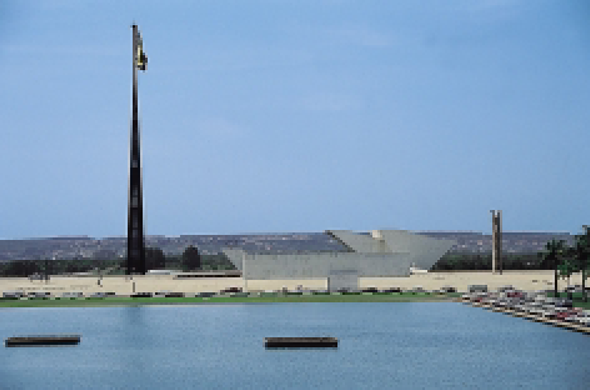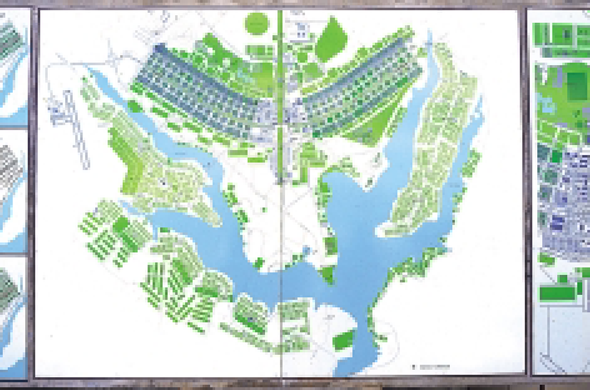New Era vol.24 October 2001
Status of Capital Relocation in Brazil
The capital of Brazil was relocated from Rio de Janeiro to Brasilia in 1960, mainly for the purpose of promoting the development of Brazilian inland areas, which had been left underutilized, and to encourage the balanced development of national land and growth of the Brazilian economy. In this issue, Mr. Hiroo Nanjo, an architect familiar with Brasilia, will introduce how Brazil coped with capital relocation.
from
New Era vol.24 October 2001
~Think Together about the Capital Functions Relocation of Japan~
Ministry of Land, Infrastructure and Transport
Contributed by: Mr. Hiroo Nanjo, an Architect

In Brasilia, the new capital of the Federative Republic of Brazil lying on the Brazilian Central Plateau, a magnificent ceremony was held in April 2000 in commemoration of the fortieth anniversary of its construction. Though Brasilia surprised the world with its Diet Building and Cathedral of modern architectural design, but its construction caused severe inflation, was labeled as an inhuman urban construction with priority given to cars, and had been Severely criticized as “The Most Unsuccessful Plan of the Century.”
However, Brasilia has grown to a large city with a population of nearly two million, becoming the most popular city in the South American Continent after only forty years. Its central district, called Plano Pilot, famous for its airplane-style design, was registered as a world cultural heritage site in 1987 to be preserved as one of the cities representing the twentieth century.
Topics 1. Sequence of Events until Capital Relocation
In the middle of the eighteenth century, discussions on capital relocation were started mainly from the point of view of national defense.
In 1889, capital construction at approximately the present location was provided in Article 3 of the Republican Constitution.
In 1946, the intent to construct the new capital was declared in the new constitution.
In 1956, planning, design and construction of the new capital, Brasilia, were promoted by President Kubitschek.
In 1960, the capital was finally relocated after fast construction taking only three and a half years.
Topics 2. Objectives of Capital Relocation

It was considered necessary to construct the new capital at its present location in the Central Plateau, located at about the same distance from major cities in the country, for the purpose of changing the economic structure in which the economic cores were concentrated in cities on the Pacific Ocean coast as well as aiming at the balanced development of national land utilizing the abundant natural resource



Topics 3. Model of the Capital Function City.
The streets of Plano Pilot District, purely focusing on capital functions, can be said to constitute one of the most unusual cities in the world. The unique urban landscape of the capital of the Federal Republic with its Supreme Court, Presidential Office, and Diet Building laid out surrounding the Three Powers Square, and all ministries and agencies of the Federal Government, embassies, and pivotal military facilities standing in orderly lines, can be said to result from the drastic pursuit of rationality of the
capital functions of a country.


Topics 4. Present Status as a “Life-Oriented City”
The housing sites, in which the people responsible for capital functions live, are located in a 240m square area called Superblock (neighboring housing lots) which have matured into a calm environment full of greenery. This demonstrate another facet of the life-oriented city of Brasilia that is unique in South America, namely in the levels of public security, education, and earnings. The city is connected to surrounding satellite cities by subways, and theseareas are growing into an economic urban region
independent from the capital function city.
Topics 5. Significance of Designation as a “World Cultural Heritage” site.

Brasilia is the youngest cultural heritage site in the world. Among the standards for registration, it was evaluated to be a masterpiece demonstrating human creative talents and a sample of architectural assembly showing important steps in human history. It is a sample of a model city constructed through modern urban planning theory in the twentieth century.
Topics 6. What Can We Learn from Brasilia?
It would be meaningless for us to superficially imitate this city on the opposite side of the Earth whose history and social systems are utterly different from Japan. However, it is possible for us to learn from Brasilia as an example of a new city image purely focused on capital functions, modern urban planning, and architecture.
